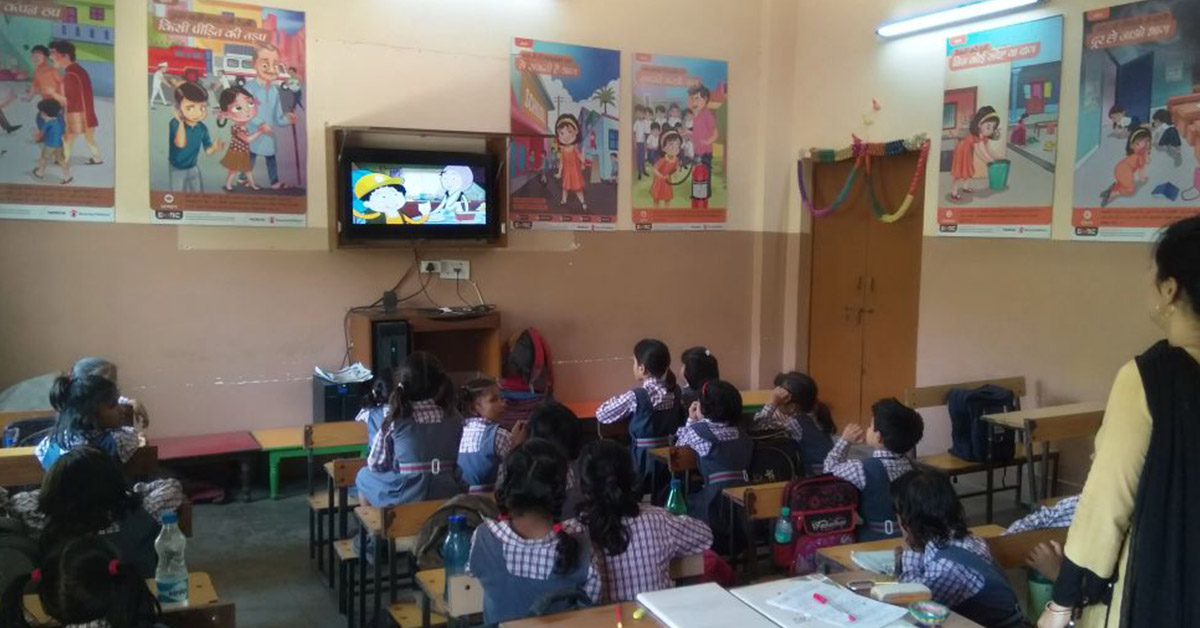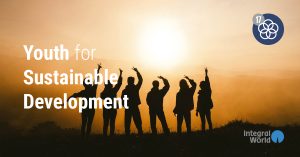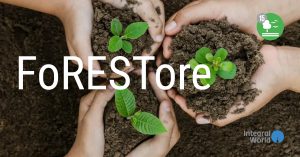Partner: Save the Children
Sector: Nonprofit
Location: 350 villages across five Indian states, viz. Andhra Pradesh, Bihar, Delhi, Rajasthan, and Tamil Nadu
Language: Hindi, Tamil, Telugu, English
SDGs: GOAL 4: Quality Education, GOAL 11: Sustainable Cities and Communities, GOAL 13: Climate Action, GOAL 17: Partnerships to achieve the Goal
Implemented: 2016
Building the Resilience of Children and Communities by integrating DRR and Social Protection
Save the Children is India’s leading independent NGO and child rights organisation, with a presence in 18 states (as of 2015). Started in 2008 in India, as “Bal Raksha Bharat”, Save the Children has changed the lives of more than 6.1 million people. In 2015, they reached 13.47 lakh children during emergencies such as natural disasters or humanitarian crises. Their pioneering programmes address children’s unique needs, giving them a healthy start, the opportunity to learn and protection from harm.
Nokia is a global leader in the technologies that connect people and things, and driven by the belief that being part of the solution to today’s global challenges is their duty. To do so, they are working with NGOs and key stakeholders to improve people’s lives with technology and build resilience and response to natural disasters.
With the aim of building resilient children and community, Nokia and Save the Children, for the first time integrated Disaster Risk Reduction (DRR), Child Sensitive Social Protection (CSSP) and Technology together. The three level intervention, spanning 350 villages, is an experiment to establish that with the help of social protection schemes, children can be secured; with the knowledge of disaster risks the community can be empowered; with technology, future risks can be mitigated; and with all three knitted together, resilience can be built.
The project’s key deliverable which involved Integral World (then ThotIn), required designing a Disaster Management Resource Centre which would help build up the DRR and CSSP capacity of children, teachers, ICDS, and frontline workers and establishing School Disaster Management Resource Centres (S-DMRCs) to promote the safety and protection of children.
“Through this program, we are making good progress in facilitating the last mile connectivity in bringing vulnerable children and their communities closer to government institutions for better implementation of disaster management policies and planning.” ~ Thomas Chandy, CEO, Save the Children
Understanding the interplay of DRR, CSSP, and Technology
The project aimed to lay the foundation for the longer-term intervention via building an enabling environment among the children, communities and governance as well as other stakeholders, in the targeted geographies. The project design included diverse elements ranging from awareness building of targeted communities on DRR and CSSP to technological solutions. For this we examined how, while DRR knowledge is life-saving, access to social protection schemes is life-sustaining. DRR activities focus largely on preparedness, prevention and mitigation of disaster related risks.
Government-run social protection programmes can significantly reduce the vulnerability of children as well as their families, and thereby contribute to building their overall resilience. The positive outcomes for children from social protection measures include increases in family spending on education and health, improvements in their nutritional status, decrease in school absenteeism, and a decline in child labour incidences.
Factoring in DRR when designing social protection programmes ensures that the impact of disaster-related loss of income and social circumstance on children – such as school absenteeism or child labour – is minimized. The use of relevant technology can ensure that social protection entitlements are accurately distributed, in a timely fashion. Importantly, technology can help access information about available social protection entitlements and the processes for availing these.
“Children are at once the most vulnerable members of any community while also being future members through whom the community can grow. In working with them towards becoming responsible community members, even at a young age. Through this project we could help in not just building resilience but building communities themselves.” Megha Roy Chowdhury, Senior Project Manager, Integral World
Envisioning a Disaster Management Resource Centre (DMRC)
While disasters equally affect people across the various social spectra of age, religion, caste, gender, etc., children are the most vulnerable and require special consideration when preparing for emergencies. Natural calamities can disrupt children’s lives severely by interrupting their education and overall development. Thus, while post-disaster resource outlays must include dedicated relief measures for children, improving children’s awareness via engaging them in programmes and training sessions organized by schools are necessary to empower them. Children need to be encouraged to be more inquisitive about the impact of natural disasters, especially in areas prone to such calamities.
Through our research, we discovered that in many communities it is not just the children who require more awareness and access to information, particularly through the use of technological tools. Through our visits to community schools, we came to understand that the members were aware of local phenomenon as devastating as some of the disasters we were already studying. The project areas have significant variations in the type of vulnerability to disasters. For example, while Rajasthan is more prone to droughts, Bihar experiences floods more. The coastal regions of Tamil Nadu and Andhra Pradesh have a history of cyclones playing havoc whereas those living in Delhi have witnessed earthquakes. Each of these disasters corresponds to a distinct set of response mechanisms, relief measures, and humanitarian assistance.
We felt it important that communities have immediate access to all relevant information pertaining to the disasters their regions might experience. Additionally, it is crucial to empower each community with the knowledge of social protection programmes as well as the means of accessing them. Putting this together and taking into consideration technological needs led us to the concept of Panchayat Disaster Management Resource Centres (P-DMRCs) which would serve communities as both an information centre as well as a technological hub for accessing relief agencies – and thereby humanitarian assistance – without delay. This would allow them to take charge of calamitous situations independently.
The DMRC is thus a node for resilience building through being a resource centre for disaster risk reduction as well as social scheme awareness and disseminating critical information for community members. Each such centre would also be provided with the equipment necessary for early disaster warnings, search and rescue efforts, as well as medical aid. A school DMRC (S-DMRC) can motivate students to study and actively participate in school safety measures, besides working with teachers and other adults in the community towards minimising risk before, during and after disaster events.
Engaging children through an S-DMRC
A major component of the DMRCs, including school DMRCs, involved information and communication technologies. We undertook field exposure visits to interact with children as well as teachers and facilitators to understand region-specific behaviour and preferences, as well as gauge their awareness of disasters and social protection programs. We covered schools both in the north and south of India, engaging with students of age 7-12 years.
Our interactions discussed six types of disasters, viz. earthquakes, fires, drought, tsunamis, cyclones, and floods, besides such social protection programmes as widow and old-age pensions, anganwadis, scholarship schemes, etc. From these discussions, we discovered that the children had little awareness of the disasters in their region, and they were largely unaware of the role they could play. However, they were eager to help others even if not prepared. They responded better to visual communication techiques, and connected with the personal stories, in their own regional language, most.
Based on these insights, we adopted four key tactics for shaping our communication material, as elaborated below.
Breaking down the approach towards disaster into stages
We felt that a storytelling strategy would work best, especially if this involved children sharing their experiences of dealing with disasters. Accordingly, we put together a 5A approach covering:
- Acknowledge: What to know about handling emergency situations
- Arrange: How to prepare for disasters well in advance
- Avoid: What actions should be taken during disasters
- Assess: How to deal with the aftermath of disasters and cope with stress
- Assist: How to help others stay safe
Story-telling using mascots representing the disasters
We then fine-tuned this story-telling approach by creating central characters with whom the children connected easily. These mascots represented the six kinds of disasters, with personality traits based on children from various communities and age-groups, as detailed below.
Cyclone – Tufaan: Tufaan is a 9-year-old city boy, modern and smart. His hair is done up nicely and he always stays in style.
Earthquake – Bhumika: An 8-year-old city girl, Bhumika wears her hair in the traditional 2-plait style using ribbons for a flourish.
Fire – Agni: Agni is a town girl of age 7, the youngest among our mascots. She is born into a high income family and wears nicely frilled frocks.
Flood – Badu: A village boy who eats a lot and is therefore a bit plump. He is 12 years old and likes to help everyone around him.
Drought – Sukhi: A lean and skinny town boy, he is swift in his actions and is extremely honest in his thoughts.
Tsunami – Sunina: She is a village girl and eldest among all the mascots. A highly inspiring, simple living girl, Sunina wears an Indian suit and is always ready to share her knowledge and experience with others.
Using rhyme-like content for easier memory retention and increased recall value
The use of rhymes helped capture the children’s attention better and also improved their retention of the lessons imparted. Kids relate easily to poems and jingles and learn faster. They can themselves sing and narrate, spreading the message further.
Creating a visual presentation through colorful and cheerful illustrations
We used colorful and cheerful illustrations to creatively represent and demonstrate the various stages of disasters, as these elicited a better response from the children. Our illustrations reflect a pan-Indian approach to ensure that a child in Delhi and a child in Tamil Nadu can relate to the illustrations similarly while taking away the same messages.
Integrating these into the DMRC involved placing messages connected with the six disasters featuring the respective mascots as well as a series of posters discussing the complete journey through a disaster cycle – awareness, preparedness, action during disaster, action after disaster, assisting others. As a further means of driving home the message, we created coloring books which the children could use as a family-oriented activity. Also included were posters detailing the social protection programmes available to the community. These also tied into the objective of creating a community-based monitoring mechanism to ensure quality delivery of essential social protection services. Children also actively participated in hazard hunts in their schools using a toolkit which helped them understand the dangers surrounding them.
“The storytelling approach of the project helped deliver the messages to the children from different backgrounds and locations in a most simple way. The strategic approach and the creative presentation further helped in bringing key messages interactively to our target audience. I am glad to have Integral World as our communication partner on this project.” ~ Abinash Lahkar, Save the Children
“Children are at once the most vulnerable members of any community while also being future members through whom the community can grow. In working with them towards becoming responsible community members, even at a young age, I had a fascinating insight into building not just resilience but the communities themselves.” ~ Manisha Munjal, Director, Integral World
Taking the next step to transforming more communities
As of 2016, 420 ICT sets were functioning across 350 communities, with School DMRCs established in 334 schools. In many of these schools, the teachers have not only conducted sessions on disaster risks and preparedness, they have also used the resources to teach students general science, maths, etc. with many taking up computer literacy. This has helped children feel empowered and confident. The programme has thus far touched the lives of close to 1.1 million community members including 350,000 children.
The focus hereafter is on taking the above mentioned models to the different levels of governance via advocacy efforts such as district and state, for large scale recognition and replication as well as embedding child-centric resilience building in communities, schools and local governance structures. The DMRCS will, in effect, function as knowledge-building centres.
Keywords: Disaster, Risk, Disaster Risk Reduction, Social Protection, Child Sensitive Social Protection, pensions, cyclone, flood, drought, fire, earthquake, tsunami, children, anganwadi, advocacy, communication technology, absenteeism, child labour, disaster management




